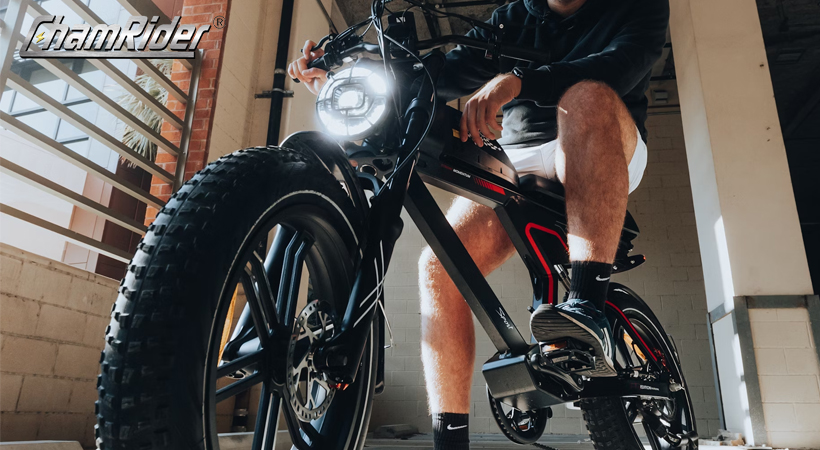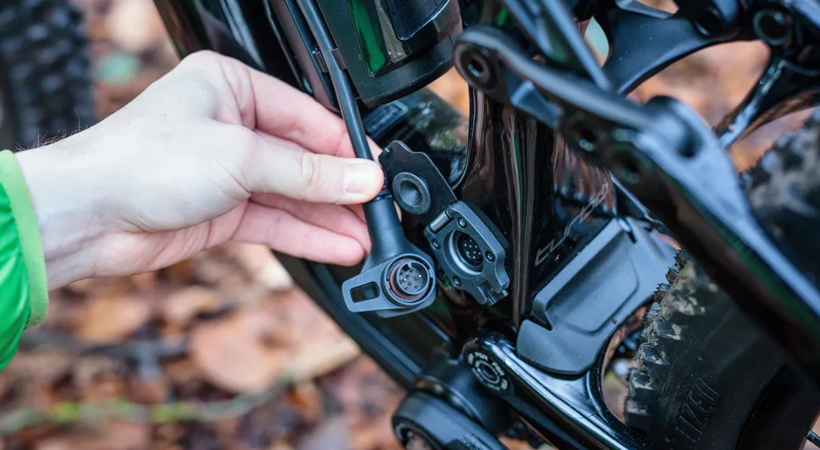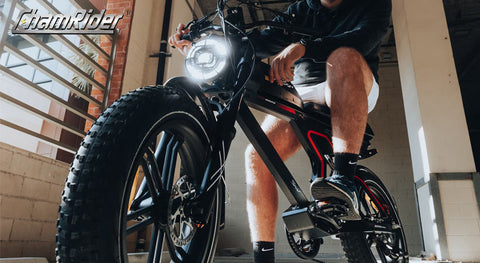Almost all electric bicycles are powered by lithium-ion batteries. These batteries have a very high energy density, which makes electric bikes relatively lightweight while providing long range. Despite the advantages of lithium batteries, one major challenge they face in terms of safety is the potential release of energy in the form of a fire if something goes wrong.
In terms of suppliers, ChamRider ensures that we use the highest quality materials in our batteries, such as LG/Panasonic lithium-ion batteries. They also design batteries with protections against overcharging, over discharging, overcurrent, temperature cutoff, and many other safety features.
At ChamRider, everyone shares the core belief in educating customers about the potential hazards and the importance of taking preventive measures to ensure their safety.

This article aims to provide you with a useful guide. Therefore, we will discuss tips for safe charging and storing of lithium-ion batteries, as well as measures to take in case of emergencies.
How to Safely Charge an Electric Bicycle Battery
Most reported battery fires occur during the battery charging process. Therefore, consumers must be extra cautious when charging. Here are some tips regarding the correct charging process:
Always use the charger recommended by the manufacturer; if you purchase an aftermarket charger, ensure that it has UL certification and specifications identical to the original charger. Using a fast charger for non-fast-chargeable batteries can be dangerous.
Avoid placing the battery near heat sources such as heaters. High temperatures can damage lithium-ion batteries and lead to thermal runaway incidents.
Do not place the charger or battery on or near flammable materials like wooden furniture or building structures. Always try to place the charger and battery on a fire-resistant surface or space.
Always keep the battery within sight while charging. As an additional precaution, place a smoke alarm near the battery.
In the event of a fire, the initial few seconds are crucial as you still have a chance to extinguish it before it becomes uncontrollable; therefore, prompt response is essential.
Turn off the battery while charging.
It is normal for the charger to become warm during the charging process, but the battery should never become hot (warm to the touch). If you notice the battery becoming hot, disconnect it.
Avoid charging in temperatures below zero degrees as this can cause dendrite growth on lithium-ion batteries, leading to short circuits and fire incidents.
Charge in a well-ventilated area.
Do not leave the battery charging overnight.

Proper Storage of Lithium-Ion Batteries
The lithium-ion battery of your electric bicycle requires proper storage, and you can take some measures to ensure appropriate storage.
When storing the battery for an extended period, charge it to around 60%.
Avoid storing it in extreme temperatures or high humidity.
Do not use damaged batteries that are dropped, punctured, squeezed, or otherwise compromised.
If a lithium-ion battery catches fire, use a fire extinguisher to put it out (be cautious as such fires produce toxic smoke).
Avoid extinguishing lithium-ion battery fires with water, although it can be used to extinguish the fire, a report by the U.S. Department of Energy found that it requires excessive amounts of water.
Do not store batteries or charge them near a single point of exit.
Safe Use of Lithium-Ion Batteries
If the battery starts smoking, making unusual noises, or shows signs of melting, stop using it immediately and place the battery in a safe location.
If you notice drastic changes in voltage/performance, discontinue using the battery.
If you immerse the battery pack/bicycle in water, have it professionally inspected before using it again (moisture inside the battery pack indicates water has entered and may cause a short circuit)?
Always use the battery with the product it comes with; do not use it for any other purposes.

Emergency Response Measures
For any electric bicycle owner, following the tips mentioned earlier can reduce the likelihood of emergencies. However, accidents can still happen. Therefore, it is important to familiarize yourself with measures to ensure the safety of yourself, your loved ones, or anyone around you.
In general, when a lithium-ion battery catches fire, you can take the following three steps:
Use a fire extinguisher:
Depending on the size and type of the battery, there are several methods to extinguish a lithium-ion battery fire. You need to react quickly and prevent the fire from spreading.
Since fires caused by lithium-ion batteries are classified as Class B fires, you should choose a standard ABC or dry chemical fire extinguisher. The Class B classification is intended for distinguishing flammable liquids. As lithium-ion batteries contain liquid electrolytes, they fall under this category.
When burning, the toxic liquid acts as a conduit for the fire, aiding in its rapid spread.
You can use the fire extinguisher to spray the flames until the fire is extinguished. The steps are as follows:
Pull out the safety pin to enable the use of the fire extinguisher.
Aim the nozzle at the base of the fire.
Squeeze the handle firmly.
To ensure the flames are completely extinguished, sweep the nozzle back and forth at the base of the fire.
Take the battery outside the building:
If you suspect any issues with the battery, such as excessive heat, liquid leakage, or unusual noises, you should place it in a safe, open outdoor space and wait for the battery to return to normal. Note that you should not attempt to handle a battery that is on fire or leaking, as it may pose a danger to you.
If the battery catches fire, wait for all the batteries to burn out, and then attempt to extinguish the fire.
Call the fire department:
Fires caused by lithium-ion batteries fall under the category of thermal runaway incidents. Subsequently, a fire involving an electric bicycle battery can present multiple hazards, such as toxic smoke, flames, and metal projectiles. After taking the necessary measures mentioned above, if you are unable to control the fire, contact the nearest fire department in your area.
Assess the severity of the situation and avoid approaching a burning battery. If you are not comfortable handling the fire, wait for the firefighters to arrive.

What safety features does the ChamRider Electric Bike Battery contain?
In order to ensure that our products meet your highest quality and safety expectations, ChamRider seeks and has been granted Canada's first UL 2849 electric bicycle certification.
The latest advancements in Battery Management Systems (BMS) allow for better control of the electric bike's battery pack from various aspects, such as battery operation and its charging and discharging. ChamRider's ultimate goal is to optimize the battery's performance and lifespan.
While we ensure to provide electric bike batteries that exceed industry standards, here are some safety features of ChamRider batteries.
Charging Protection (Voltage and Current)
If the charging voltage or current exceeds the specified range, ChamRider batteries will cut off the charging process; this ensures that charging is stopped in case of any faults.
Battery Balancing
Battery balancing improves the available capacity of the battery; additionally, unbalanced batteries may be damaged and result in malfunction over the long term. That's why ChamRider batteries are equipped with battery balancing and battery balancing cutoff functions. This way, if one of the batteries is permanently damaged and unable to balance, the battery will shut down.
Discharge Protection (Voltage and Current)
During product operation, voltage and current values are measured; if the voltage is too low or the current value is too high, the BMS will cut off the battery for safety reasons.
Short Circuit Protection
Short circuits in lithium-ion batteries are always dangerous. They can damage your battery and shorten its lifespan. In the worst-case scenario, a short circuit can pose serious risks such as battery fires or explosions, resulting in personal injury, property damage, or even death. ChamRider batteries have short circuit protection designed to monitor battery voltage and prevent hazardous situations caused by battery short circuits.
Temperature Cutoff Protection
ChamRider lithium-ion batteries incorporate temperature cutoff protection mechanisms that shut down the battery when the temperature exceeds the safety threshold.
Conclusion
Today, lithium-ion batteries are widely used in electric bikes. While these batteries themselves are not inherently dangerous, improper handling by some electric bike users has resulted in numerous fire incidents. This article discusses the safety measures to be taken during lithium-ion battery charging.
We also discuss the proper usage and storage methods that can be followed when dealing with such batteries.
Lastly, we discuss the safety measures taken by ChamRider to ensure the use of high-quality batteries in our electric bikes. These measures include short circuit protection, battery balancing, discharge protection, and temperature cutoff protection.




Комментарии (0)
К этой статье нет комментариев. Оставьте первое сообщение!